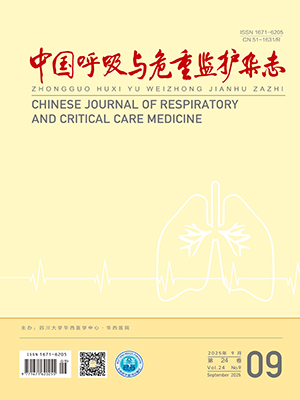| 1. |
蔡柏蔷. 慢性阻塞性肺疾病诊断、处理和预防全球策略(2017GOLD 报告)解读. 国际呼吸杂志, 2017, 37(1): 6-17.
|
| 2. |
张小娥, 张彩莲. 慢性阻塞性肺疾病流行病学及疾病经济负担研究进展. 中国慢性病预防与控制, 2017, 25(6): 472-476.
|
| 3. |
祁玉诚, 侯淑萍. 慢性阻塞性肺疾病的流行病学调查及影响因素分析. 中国现代药物应用, 2017, 11(4): 77-79.
|
| 4. |
Saghazadeh A, Rezaei N. Inflammation as a cause of venous thromboembolism. Crit Rev Oncol Hematol, 2016, 99(3): 272-285.
|
| 5. |
蔡柏蔷, 白春学. 慢性阻塞性肺疾病急性加重(AECOPD)诊治中国专家共识(草案). 中华哮喘杂志 (电子版), 2013, 7(1): 1-13.
|
| 6. |
冯修武. 慢性阻塞性肺疾病急性加重期合并肺栓塞原因分析. 现代仪器与医疗, 2016, 22(3): 57-59.
|
| 7. |
李有霞, 郑则广, 刘妮, 等. 慢性阻塞性肺疾病急性加重伴肺动脉栓塞的危险因素分析. 中华结核和呼吸杂志, 2016, 39(4): 298-303.
|
| 8. |
Pannucci CJ, Obi AT, Timmins BH, et al. Venous thromboembolism in patients with thermal injury: a review of risk assessment tools and current knowledge on the effectiveness and risks of mechanical and chemical prophylaxis. Clin Plast Surg, 2017, 44(3): 573-581.
|
| 9. |
王丹凤, 王兰, 吴晓东. 舒利迭吸入剂联合复方血栓通胶囊对老年稳定期 COPD 患者血栓前状态的影响. 实用老年医学, 2016, 15(8): 651-653.
|
| 10. |
朱肖星, 朱萧玲, 陈定章, 等. 骨科手术后深静脉血栓的国内外现状分析和策略. 心脏杂志, 2017, 29(3): 369-372.
|
| 11. |
卓婕, 白澎, 孙永昌, 等. 低氧血症是慢性阻塞性肺疾病急性加重期静脉血栓栓塞症的危险因素. 中国呼吸与危重症杂志, 2011, 10(2): 112-115.
|
| 12. |
朱松楠, 韩林飞. 原发性纤维蛋白溶解症二例临床分析. 国际妇产科学杂志, 2017, 44(4): 448-449.
|
| 13. |
金红, 闫海润, 李琪, 等. D-二聚体联合 Wells 评分在静脉血栓栓塞性疾病诊断中的应用价值. 医学研究杂志, 2017, 46(4): 100-102.
|




